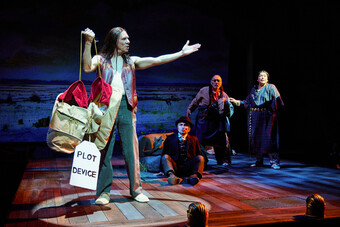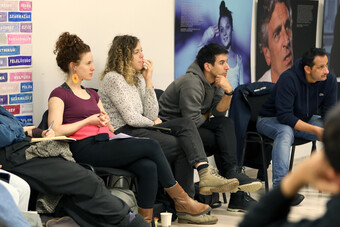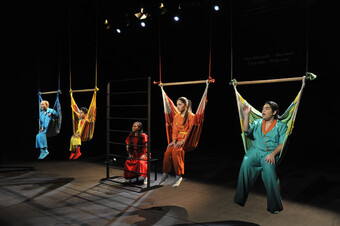2013 HowlRound NewCrit Round Up
January 2014 marks the three-year anniversary of the launch of HowlRound. This year saw the birth of the NewCrit section on HowlRound, a new platform for penetrating and panoramic explorations of theater and its communities, contexts, histories, and the artists and professionals who make it possible. Our NewCrit critics have expanded the repertoire of theater criticism by writing about theater big and small, performance and visual art, dance, theater festivals, the urban centers of theater, and everything in between. They have reported from the cities of Atlanta, Boston, Chicago, Los Angeles, Minneapolis/St. Paul, North Carolina, New York, Phoenix, San Francisco, Toronto and Washington, DC. We hope, with the help of our writers and readers, to continue these invigorating, exciting, and incredibly important conversations about the work on stage.
For now, we leave 2013 by offering you an assortment of quotes from the HowlRound’s NewCrit this past year.
I mention this because the show in question, The Gay Heritage Project, at Buddies in Bad Times Theatre in Toronto, is not the Gay History Project. It’s about more than just gay history (setting aside for a moment the question of whether it makes sense to talk about such a history, of which more in a moment); rather, the show is about making sense of a heritage and in doing so it raises the very interesting questions of how performances are both manifestations of heritage and repositories of heritage. This show is an archive, a question, and a living artifact all at once. Touching Time: Choosing Gay Heritage in The Gay Heritage Project by Matt McGeachy
Ebony Jo-Ann reprised her Ma Rainey triumphantly, and the same is true of Anthony Chisholm and Phylicia Rashad’s powerful performances of Solly Two Kings and Aunt Ester in Gem of the Ocean. The Piano Lesson reassembled completely the cast and director of last season’s wildly successful production at the Signature, giving audiences the opportunity to meet Roslyn Ruff’s masterful Berniece again as well as to hear Chuck Cooper, James A. Williams, Brandon Dirden, and Jason Dirden sing “Berta Berta” one more time: a standout moment from the series. August Wilson Takes New York by Patrick Maley
Though the actors in these companies are in it for the opportunity to play great roles and not to study sociology, the fact that their characters are men means that acting the part is different than it is when they play characters of the same sex, and that involves understanding the ways behavior is gendered. Bruneau has interesting insights into the outside-in process of building a character, who has a different relationship to the world by virtue of his gender than the female actor. Playing Shakespeare’s Men by Holly L. Derr
And so, the pace in baseball is alternately a meditation and a flash, with attention pricking on a central drama between the pitcher and the batter, while allowing for unbelievable performances (Willie Mays comes twirling to mind) in the field. The kind of experience that can occur within the game, if you are awake to it, is at least as varied as what can happen in most narrative drama and raises the transfer of energy with an object to its perfection. A Ballgame by Allison Vanouse
But inextricably tied to those questions, of course, is a question about the content of those plays: Do their female characters represent as wide a range of the human experience as their males? In a world in which we actually have to ask this question, to make your young female characters complex and authentic is not just important artistic practice; it’s important political practice. Our Own Best Judges: Young Female Characters on Stage by Lily Janiak
The Simpsons is an incredibly rich text, stuffed with intricate throwaway gags that make each episode endlessly watchable, and—as Anne Washburn's characters quickly figure out—surprisingly hard to remember in full. Everyone knows The Simpsons, and that shared understanding is strong enough to support anything Washburn wants to make of it. By the end of the second act of Mr. Burns, she has stripped America's longest-running scripted show down to its essentials, allowing her to build something entirely new out of familiar parts. When The Lights Go Out, Dumb Jokes Keep Us Warm by W.M. Akers
Some of the lyrics in The Jungle Book are absolutely problematic and cannot be ignored." I want to be a man like you,” when sung by a black actor, has inevitable, historic and racist undertones. This repeated lyric jumps out at me every time it is sung in the Act I closing musical number. Mary Zimmerman winks at this problem with a moment of acknowledgment in which the ensemble pokes fun at British colonizing culture, holding up white teacups, sitting with rigid postures, and over articulating their vowels as they sing “I want to be a man like you-oo-oo.” Race Representation in The Jungle Book by Dani Snyder-Young
T.S. Eliot called Titus Andronicus "one of the stupidest and most uninspired plays ever written…” Samuel Johnson deemed it impossible to produce—“the barbarity of the spectacles,” he said, “and the general massacre which are here exhibited can scarcely be conceived tolerable to any audience.” But Taffety Punk, resident company at Washington DC’s Capitol Hill Arts Workshop, has taken on the challenge. Titus Andronicus is the most recent in a series of Shakespeare plays the Riot Grrrls, as they call themselves, have produced with an all-female cast. Taffety Punk’s Riot Grrrls Wring Humor From Titus Andronicus by Patricia Davis
I saw Roadkill in Brooklyn, three years after its premiere in 2010 at the Edinburgh Fringe. It is based on the true story of a girl from Nigeria whom Bissett met through her volunteer work, who at the age of thirteen was trafficked to Scotland and forced into prostitution for four years before she managed to escape. Political Immersion in Roadkill and La Ruta by Bertie Ferdman
Disabled characters aren’t prominent in theater, but they are present. Popular plays featuring disabled characters include Richard III (title role), The Glass Menagerie (Laura), recently Clybourne Park (Betsy). There have also been plays that use disabled characters as vessels for disabled actors (The Jelly Bean Conspiracy, Children of a Lesser God). soot and spit was both. The Affects of Disability Portrayal and Inclusion in soot and spit by Alice Stanley
Of the one hundred and seventy six shows performing at sixteen venues over the course of eleven days, it is only humanly possible to see fifty six. As I bicycled from venue to venue, and what seemed to be at the time a never-ending stream of performances, I began to wonder how would I cover the festival? Minnesota Fringe and Minnesota Nice by Chris Garza
As in most museum exhibitions, the panel recounts the materials involved in the installation. There it all stands arranged before my eyes: a carefully constructed diorama of mounted animal trophies, maps, and skulls straight out of a nineteenth century fantasia of the "dark continent." Regarding the Pain of Others (Part Two): Brett Bailey’s Exhibit B by Daniel Sack










Comments
The article is just the start of the conversation—we want to know what you think about this subject, too! HowlRound is a space for knowledge-sharing, and we welcome spirited, thoughtful, and on-topic dialogue. Find our full comments policy here